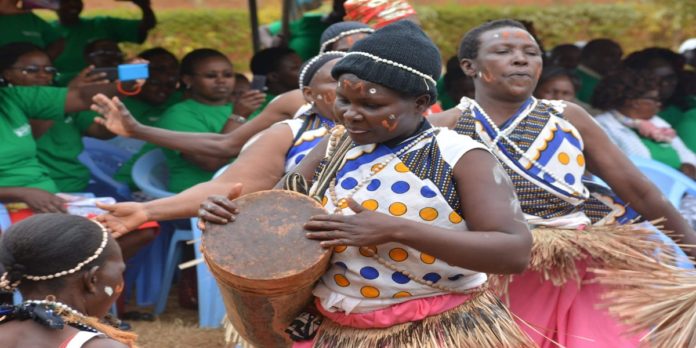Every morning, a harmonious voice crosses the airwaves and finally lands in the countryside of Kajiongo village in Tharaka Nithi county. Here it meets people shut from modernization, and wake them up to the rhythm of the day.
The voice is Mwenda Antu radio. A community-based radio airing vernacular educational programs, updates and entertainment in this geographic location.
Just a few months ago, the little community could be accessed only through a one-way path that came to a dead end. However, the radio facilitated the opening of the village by forwarding their grievances to elected officials who responded by initiating the construction of abandoned roads.
This was briefly after the first case of Coronavirus was reported in the country. At that time, the radio had found itself with a challenge of reaching out to people.

Today, a network of roads converges at this community. Some constructed and others are underway.
”The road here was demarcated before independence. It had begun to disappear until Mwenda Antu radio came, and we expressed our challenges to our elected representatives,” says Muriuki, 65, as he points to the trail of road under construction.

Besides acting as the intermediary between the people and their representatives, the radio seeks to fill the literacy gap by offering educational programs. Occasionally, agricultural and health experts are invited to extend their knowledge to the residents.
Evidently, improved agricultural practices have increased their produce giving them enough food during challenging times of the drought and pandemic.
In the complex world of cutting-edge technology, a radio would not seem useful. This is not the case for Kajiongo community.
Constructed roads which now link this remote village has enabled Village HopeCore, a non-profit organization, to provide home-based maternal healthcare to girls and women, having reached more than 500 homes so far.

Village HopeCore is committed to eradicating poverty in the villages through mobile health care, education, and empowerment.
“We provide hold educational meet up with girls and women while providing mobile healthcare,” says Mutwiri, a field health practitioner for Village HopeCore.
Through the agency of over 200 trained community health volunteers, Hopecore mobile healthcare programs have managed to help many vulnerable girls in these communities.

For instance, Acosta, who is a community health volunteer, was notified about an incident where a 17-year-old girl from Ikumbo community had decided to get rid of her pregnancy by drinking a bottle of bleach.
She had no one to support her, so he visited and referred her to Magutuni sub-county hospital. Even then, she was determined to commit suicide. Through relentless effort, he advised and counseled her until she eventually accepted her situation and agreed to attend ANC clinics. Currently, she is relaxed and awaiting delivery.

For many women, the thoughts of pregnancy bring on a feeling of excitement. However, for teenage girls, forced into adulthood with hard decisions to make, it’s associated with uncertainty, fear and anxiety.
Equally important, Village Hopecore reaches out to school girls and give them free sanitary pads (enough to last for 6 months). Frequently, lack of sanitary towels lead them to engage in ‘sex for pads.’ Thereafter, they educate them on menstrual hygiene management and sexual reproductive health and rights.

According to the Grace Cup report, 65% of girls and women in Kenya cannot afford sanitary pads due to poverty. 1 in every 10 Kenyan adolescent girl ends up missing school during her menstruation period which affects her performance.
“We know that young girls who get pregnant do not access healthcare services like adult females because of the judgment,” said Ademola Olajide, the United Nations Population Fund representative in Kenya.
That makes them more vulnerable to health complications and unsafe abortions, he added.
Globally, pregnancy and childbirth are the leading causes of death for girls aged between 15 and 19, according to the World Health Organization.
Mwenda Antu radio and Village HopeCore are among many other organizations giving hope to vulnerable populations.
Whereas the pandemic has impacted many aspects of our society, reproductive healthcare is among the worst hit.
Two months ago a video surfaced on social media appearing to show a woman on labor delivering outside the gate of a reputable hospital while Health workers neglected her. It was devastating to many.
Furthermore, in recent past cases of babies disappearing from maternal units of renowned health centers in the country have raised concern about the effectiveness of reproductive healthcare particularly during COVID-19.
On the other hand, teenage pregnancies have been an obstacle, keeping thousands of adolescent girls out of school for years. Now as the students stay at home in a bid to curb the spread of the virus, more incidences have been reported.
While the social aspect of the inequality — which entails the difference in people’s physical well-being and access to livelihood opportunities such as wealth and education — affects many women overall, their plight has increased in rural areas due to lack of resources and poor infrastructure.
According to Kenya’s 2010 constitution (intended to improve the welfare of Kenya’s marginalized groups), women must have at least a third of seats in parliament and a third of appointed positions. However, the law has been difficult to apply.
The fact that the cases of girls’ and women’s rights violations keep rising, is an indication that even though they have representatives to speak for them, in most cases they are never heard.

